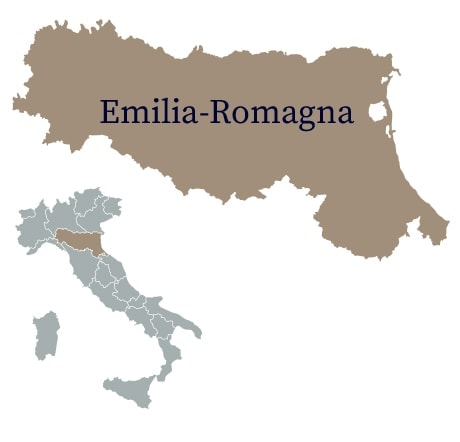
Ask any Italian what they associate with Emilia-Romagna, and they’ll no doubt say food. It’s true: even Italians, who are deeply passionate about their own regional cuisine, concede that Emilia-Romagna’s got something special cooking. Its long, rich tradition of esteemed cuisine likely dates back a couple thousand years, when, in 187 BC, the Romans built the 125-mile-long Via Emilia, connecting some of northern Italy’s biggest cities, their wealthy, fancy-food-loving residents, and the rest of Europe. Couple that history with the fertile soil surrounding the Po River, and you have a region ripe for the finest of cuisines.
To this day, the list of coveted Emilia Romagna food products is indisputably long, and includes world-renowned items ranging from Parmigiano-Reggiano cheese to balsamic vinegar, and prosciutto di Parma. Each of these claims Protected Designation of Origin status and thus, to be considered authentic, can only be made in Emilia-Romagna and by meeting various strict traditional production requirements.
Add to the region’s brag-worthy menu a seemingly unending collection of pastas, particularly egg-based ones that are stuffed with all sorts of scrumptious fillings. Think tortellini, tortelli, ravioli, cannelloni and cappellacci, just to name a few. And certain pastas — most commonly fettuccine-like tagliatelle, or classic lasagne with besciamella sauce — are often proudly accompanied by regional sauce superstar, ragù alla bolognese.
Salumi, or cured meats, also hold a special place in locals’ hearts — err tummies — the most internationally recognized of which includes mortadella (a sliced sausage that famously inspired American bologna) and the aforementioned prosciutto di Parma.
Essential street foods abound too, such as gnocco fritto, a fried cake with a collection of different regional names, and panini, flatbread sandwiches that are usually packed with cheese and those beloved cured meats.
Emilia-Romagna’s food flavors meet their match with the region’s robust selection of wines. White and red wines are produced across the region, from inland Piacenza and Parma, to seaside Ferrara, Ravenna, Cesena and Rimini. In Emilia, you can find one of Italy’s most recognized wines, Lambrusco, a sparkling, fresh and fragrant red, characterized by hints of fruit. This part of the region is also known for its frizzante (or slightly sparkling) white wines, from the aromatic Malvasia to the rich Trebbiano.
Meanwhile, in Romagna, a red wine that really makes headlines these days is the region’s Sangiovese di Romagna, a satisfying alternative to the more famous Tuscan Sangiovese. This lesser-known red offers fresh and dynamic aromas, while still holding up nicely over time. White also thrives here, such as the Romagna Albana, which is warm and compelling — perfect for an evening with friends while devouring the best of local cuisine.

Ask any Italian what they associate with Emilia-Romagna, and they’ll no doubt say food. It’s true: even Italians, who are deeply passionate about their own regional cuisine, concede that Emilia-Romagna’s got something special cooking. Its long, rich tradition of esteemed cuisine likely dates back a couple thousand years, when, in 187 BC, the Romans built the 125-mile-long Via Emilia, connecting some of northern Italy’s biggest cities, their wealthy, fancy-food-loving residents, and the rest of Europe. Couple that history with the fertile soil surrounding the Po River, and you have a region ripe for the finest of cuisines.
To this day, the list of coveted Emilia Romagna food products is indisputably long, and includes world-renowned items ranging from Parmigiano-Reggiano cheese to balsamic vinegar, and prosciutto di Parma. Each of these claims Protected Designation of Origin status and thus, to be considered authentic, can only be made in Emilia-Romagna and by meeting various strict traditional production requirements.
Add to the region’s brag-worthy menu a seemingly unending collection of pastas, particularly egg-based ones that are stuffed with all sorts of scrumptious fillings. Think tortellini, tortelli, ravioli, cannelloni and cappellacci, just to name a few. And certain pastas — most commonly fettuccine-like tagliatelle, or classic lasagne with besciamella sauce — are often proudly accompanied by regional sauce superstar, ragù alla bolognese.
Salumi, or cured meats, also hold a special place in locals’ hearts — err tummies — the most internationally recognized of which includes mortadella (a sliced sausage that famously inspired American bologna) and the aforementioned prosciutto di Parma.
Essential street foods abound too, such as gnocco fritto, a fried cake with a collection of different regional names, and panini, flatbread sandwiches that are usually packed with cheese and those beloved cured meats.
Emilia-Romagna’s food flavors meet their match with the region’s robust selection of wines. White and red wines are produced across the region, from inland Piacenza and Parma, to seaside Ferrara, Ravenna, Cesena and Rimini. In Emilia, you can find one of Italy’s most recognized wines, Lambrusco, a sparkling, fresh and fragrant red, characterized by hints of fruit. This part of the region is also known for its frizzante (or slightly sparkling) white wines, from the aromatic Malvasia to the rich Trebbiano.
Meanwhile, in Romagna, a red wine that really makes headlines these days is the region’s Sangiovese di Romagna, a satisfying alternative to the more famous Tuscan Sangiovese. This lesser-known red offers fresh and dynamic aromas, while still holding up nicely over time. White also thrives here, such as the Romagna Albana, which is warm and compelling — perfect for an evening with friends while devouring the best of local cuisine.